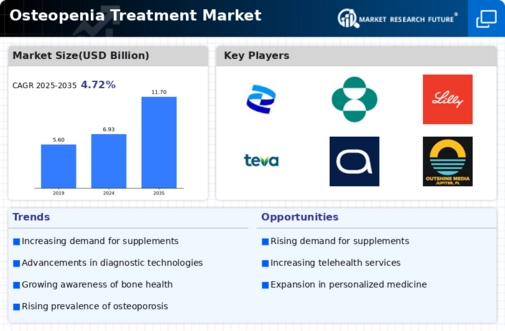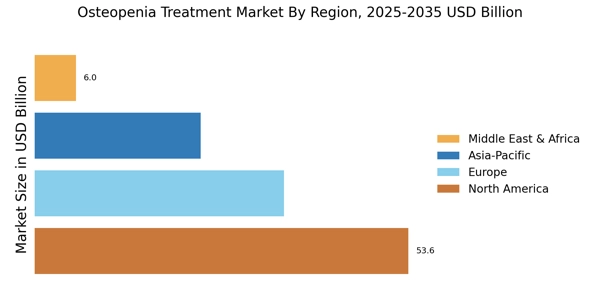Advancements in Diagnostic Technologies
Technological advancements in diagnostic tools are significantly influencing the Osteopenia Treatment Market. Innovations such as dual-energy X-ray absorptiometry (DEXA) scans and quantitative computed tomography (QCT) have enhanced the accuracy of bone density assessments. These advancements facilitate early detection of osteopenia, allowing for timely intervention and treatment. As diagnostic technologies continue to evolve, healthcare providers are better equipped to identify at-risk populations, which may lead to an increase in treatment uptake. The integration of these advanced diagnostic methods into routine clinical practice is likely to drive growth in the Osteopenia Treatment Market, as more individuals are diagnosed and treated for this condition.
Rising Awareness and Education on Bone Health
There is a notable increase in awareness regarding bone health, which serves as a significant driver for the Osteopenia Treatment Market. Educational campaigns and initiatives by health organizations have contributed to a better understanding of osteopenia and its implications. As individuals become more informed about the risks associated with low bone density, they are more likely to seek preventive measures and treatments. This heightened awareness is reflected in the growing number of screenings and diagnostic tests for bone health. Consequently, the Osteopenia Treatment Market is experiencing a surge in demand for both pharmacological and non-pharmacological interventions, as patients actively pursue options to maintain or improve their bone density.
Aging Population and Osteopenia Treatment Market
The increasing proportion of the aging population is a primary driver for the Osteopenia Treatment Market. As individuals age, the risk of developing osteopenia rises significantly, leading to a greater demand for effective treatment options. According to recent demographic data, the population aged 65 and older is projected to reach approximately 1.5 billion by 2050, which suggests a substantial increase in the prevalence of osteopenia. This demographic shift necessitates the development of targeted therapies and preventive measures, thereby stimulating growth within the Osteopenia Treatment Market. Pharmaceutical companies are likely to invest in research and development to cater to this expanding demographic, potentially leading to innovative treatment solutions that address the unique needs of older adults.
Increased Investment in Research and Development
The Osteopenia Treatment Market is witnessing increased investment in research and development, which is a crucial driver for market growth. Pharmaceutical companies and research institutions are focusing on developing novel therapies and treatment modalities for osteopenia. This investment is often fueled by the rising prevalence of osteoporosis and related conditions, which underscores the need for effective treatment options. Recent data indicates that the global market for osteoporosis therapeutics is expected to reach several billion dollars by 2027, suggesting a parallel growth trajectory for the osteopenia segment. As new treatments emerge, the Osteopenia Treatment Market is likely to expand, offering patients a wider array of options to manage their condition.
Growing Demand for Preventive Healthcare Solutions
The increasing emphasis on preventive healthcare is driving the Osteopenia Treatment Market. As healthcare systems shift towards proactive management of health conditions, there is a growing recognition of the importance of preventing osteopenia and its progression to osteoporosis. This trend is reflected in the rising demand for lifestyle interventions, nutritional supplements, and pharmacological treatments aimed at maintaining bone health. Health professionals are advocating for early intervention strategies, which may include regular screenings and personalized treatment plans. The Osteopenia Treatment Market is likely to benefit from this preventive approach, as more individuals seek to mitigate their risk of developing severe bone density issues.


















Leave a Comment